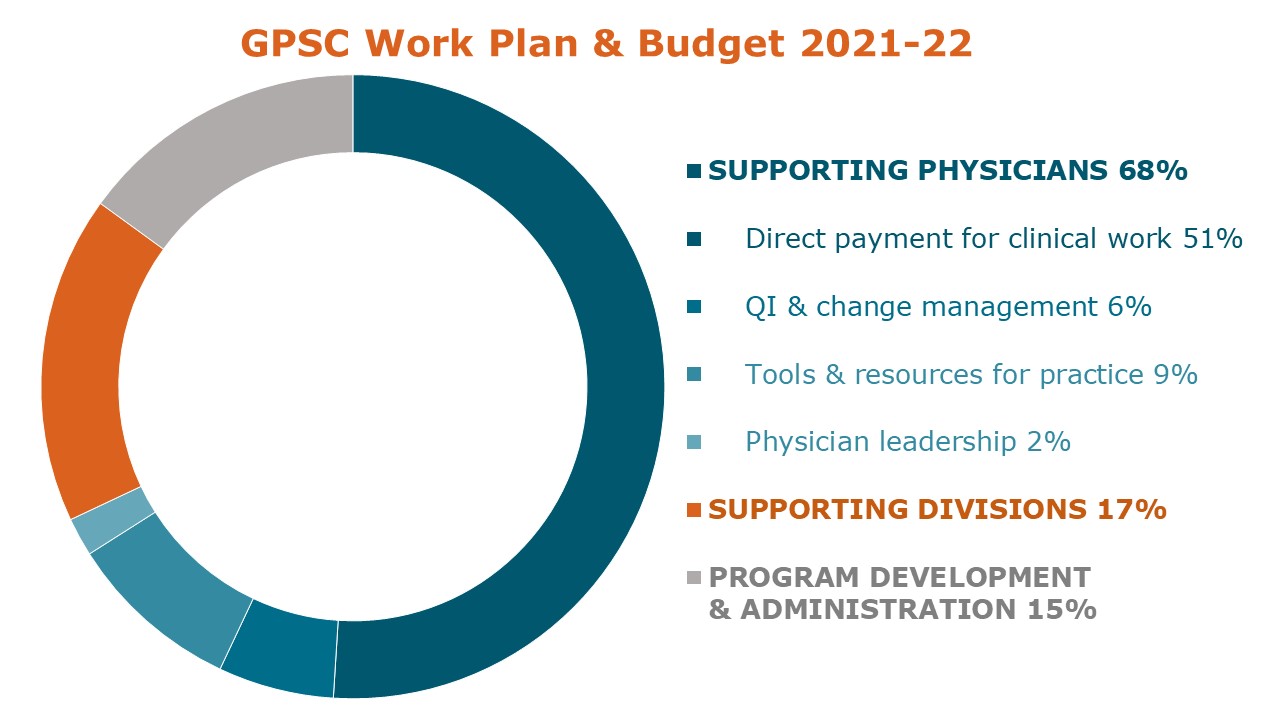GPSC often hears from members who want to know where GPSC funding is allocated, and how it benefits physicians. As part of our commitment to transparency, we have created a mini-workplan and budget wheel that shows expenditures for the 2021-22 fiscal year. The GPSC work plan was created with the mission of strengthening longitudinal family practice as the foundation of an integrated system of care. In 2021-22, we focused on key priorities: physician leadership, COVID-19, physician wellness, cultural safety and anti-racism, and mental health and addictions.
The budget wheel shows how the programs and initiatives we fund through our annual budget support these priorities and the majority of GPSC’s resources, tools, and supports go directly to doctors through payments and incentives.
In 2021-22, the GPSC work plan and budget focused on five key priorities:
- Physician leadership
- COVID-19
- Physician wellness
- Cultural safety and anti-racism
- Mental health and addictions
The programs and initiatives we funded through our annual budget support these priorities.

Many members may not know that 68% of GPSC’s resources, tools, and supports go directly to physicians through payments and incentives. These include payments to support longitudinal care, incentives, supports for practice level QI and change management, change management, networking and clinical programs, and enhancing in-patient and long-term care. Other spending includes staff to support physicians in practice as well as divisions and the teams that support GSPC programs.
Some highlights from the 2021/2022 budget, which are budgeted dollar amounts with actuals becoming available this fall, include:
- Almost 51% of the budget goes directly to physicians through payments or incentives, to support longitudinal care. For example, once a patient reaches the MSP limit of four counselling visits per year, GPSC provides four additional counselling visits per patient through the mental health management fees. This was introduced to respond to the need expressed by many family physicians that the COVID-19 pandemic has accelerated the growth of mental health needs and the risk of substance use disorder in patients. There is also a new patient intake fee for family doctors who confirm the addition of a new patient to the doctor’s panel.
- Over 17% of GPSC budget supports the 35 divisions of family practice that represent more than 230 communities. Much of this budget goes to infrastructure funding to support their core functions and collaborative work. Some of this budget is directed to physicians through sessional payments to support the work of the division.
- Almost 15% of the budget goes to program development and admin, which is similar to the administrative costs of other leading non-profits. This includes the Doctors Technology Office (DTO) that provides technical and advocacy support for BC physicians with a focus on doctors who have implemented an electronic medical record (EMR).
- About 9% of the budget funds tools and resources for practices. Examples of this are UpToDate subscriptions (available through your division), and the minor tenant improvements grant, where GPSC funds minor tenant improvements to family physician owned/leased clinics participating in their local Primary Care Networks (PCNs).
- 6% of the budget goes to quality improvement (QI) and change management tools and resources. For example, GPSC provides sessional payments to physicians for engaging in QI activities focused on improving provider and patient experience, population health, as well as value and efficiency (quadruple aim) through GPSC’s Practice Support Program and Doctor’s Technology Office.
- The remaining 2% of the budget goes to physician leadership, such as the GPSC leadership and management development program, which builds physician leadership capacity related to the overall redesign of primary care in BC.
Learn more details of the GSPC work plan and budget 2021-22 and about GPSC’s programs and initiatives on our website.
